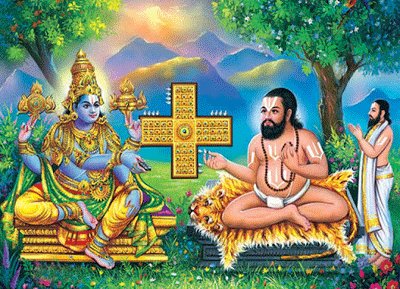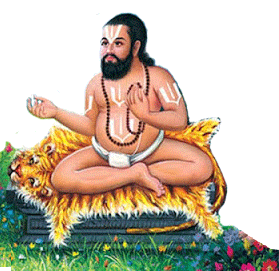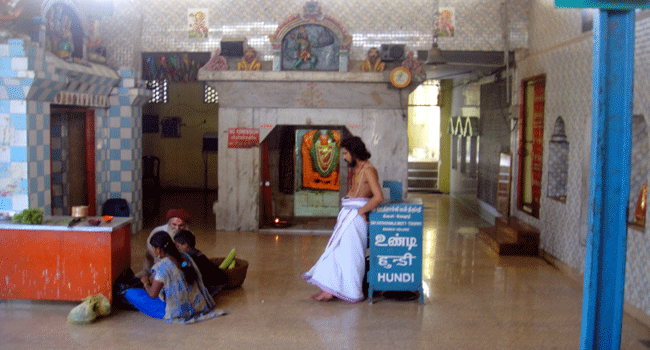
Sri Swamy Hathiramji Mutt
Sri Swamy Hathiramji Mutt was established by Mahant Hathiramji with Tirupati [Tirumala to be more specific] as the headquarters around four hundred and fifty years back. Although the exact year of formation of the mutt is not known, it is strongly believed that the founder Sri Hathiramji Maharaj had established the mutt during [Aravidu] Rayas time. Over time the mutt has established several subordinate branches at many places in Bharat in the [then] presidencies of Madras and Bombay, Bangalore City, Andhra, Tirupati, Adoni, Tanjavur, and Vellore. All these branches were being managed from the main Mutt at Tirupati. In the year 1843, the management of Tirupati temple was handed over to this mutt by the British, after long deliberation. The Mahants of this mutt continued to be dharmakarthas of the temple and managed the affairs of the temple administration till 1933.
Bairahi/Bairagi
Before proceeding to learn about Sri Hathiramji mutt, let us know who Bairahis are. Sri Hathiramji Mahant is one.
Bairahi or Bairagi is a word derived from the word vairahi which means ‘people living with a vow’. It refers to persons who lead their life intending to attain ‘moksha’. These people follow and adopt any recognised path to attain the same. There are many such bairahi who visit the holy kshetras in pursuit of their goal of attainment of ‘moksha’. A few of these saints who travelled to south India as a part of this holy trip had decided to settle down in various places in South India. Few of them had built a rest house [known as chatram or matam] for other visitors from their place of origin; in such matam, they also installed a deity of their choice and affection.
Such ‘matam’s were called Bairahi madam or Bairagi Mutt in south India. One can see many such matams in places like Arani, Kanchipuram, Chennai, Trichy, Madurai, Tirunelveli, Rameswaram, and Vellore, etc to name a few, and also at many places in present Andhra and Karnataka.
Sri Bavaji the bairagi
It happened about four hundred fifty years ago during the time of Rayas of Vijayanagara, a Bairahi who was a devotee of Sriram was on a pilgrimage to south India. As he came to Tirupati and had the darshan of Sri Venkatachalapati, he stayed for a few days and served the temple with all his might. He felt immense pleasure in serving the deity and his quest to serve Him for more time had increased.
This bairagi, who came from northern India, then settled in Tirumala. It was his practice to take a holy dip thrice a day in the Swami Pushkarini and have the darshan of the deity at the temple after the bath. At his ‘ashram,’ he will spend the rest of the time singing the glories of God, meditating upon Him.
He and his associates will help other devotees who come to Tirumala on a pilgrimage. Serving devotees of the Lord is a seva for any bairagi and this bairahi is no exception. This has earned him respect among the pilgrims to the kshestra and people addressed him as ‘bhavaji’ with respect.
According to the established practice of the mutt as the first bairahi in charge of Vellore, the deity of Sri Hanuman was recommended. With the due permission of the chief Mahant of Tirupati, the pradeshthapana of the deity of Sri Hanuman was made at this center.
Dice play of Bavaji
 Bavaji felt that Sri Venkatachalapati was close to him and his heart. During the night when he could not sleep, he would play dice. He had a peculiar habit of assuming that he was playing dice with the Lord himself. He will play the dice for the lord also. One fine night when he was playing dice as usual, somebody entered the ashram. All of a sudden the atmosphere changed. Bavaji was astonished at the divine look of the visitor and lost himself in His presence. Bavaji felt that the Lord of this kshetra Himself had come to play dice. Voluntarily the visitor started playing dice with the Bavaji.
Bavaji felt that Sri Venkatachalapati was close to him and his heart. During the night when he could not sleep, he would play dice. He had a peculiar habit of assuming that he was playing dice with the Lord himself. He will play the dice for the lord also. One fine night when he was playing dice as usual, somebody entered the ashram. All of a sudden the atmosphere changed. Bavaji was astonished at the divine look of the visitor and lost himself in His presence. Bavaji felt that the Lord of this kshetra Himself had come to play dice. Voluntarily the visitor started playing dice with the Bavaji.
This practice of playing dice continued for a few nights. The time had come that the Lord felt like conferring a boon on the bairagi devotee. Therefore He after playing dice with the Bavaji left for His abode, leaving His necklace behind at the Bavaji’s place.
The next day the archaka of the temple noticed that the necklace of the Lord was missing and he reported the matter to temple authorities. At the same time, Bavaji came to hand over the necklace left behind by the Lord at his place. While it was said that the Bairagi had stolen the necklace, Bavaji pleaded innocence and narrated what had happened the previous night. The temple authorities did not believe him and brought the matter to the Raya’s court.
Bavaji becomes Sri Hathiram Bavaji
 Raya could not believe what the bairagi said. But judicially Raya said that the bairagi be confined to a cell full of sugar cane, which he would eat overnight before dawn. Accordingly, Bavaji was confined to the well-guarded cell full of sugar cane. Aware of his innocence and with absolute faith in his Lord, Bavaji went on a deep meditation. As the Lord came as Narashimha to save Prahalladha, He came as an elephant and swallowed all the sugar cane while His devotee was meditating upon Him. At dawn, the Lord shook him off the devotee from meditation and gave him His Viswaroopa darshan as a boon to him for which he was longing.
Raya could not believe what the bairagi said. But judicially Raya said that the bairagi be confined to a cell full of sugar cane, which he would eat overnight before dawn. Accordingly, Bavaji was confined to the well-guarded cell full of sugar cane. Aware of his innocence and with absolute faith in his Lord, Bavaji went on a deep meditation. As the Lord came as Narashimha to save Prahalladha, He came as an elephant and swallowed all the sugar cane while His devotee was meditating upon Him. At dawn, the Lord shook him off the devotee from meditation and gave him His Viswaroopa darshan as a boon to him for which he was longing.
The guards of the Raya saw an elephant walking out of the cell in the dawn and all the sugar canes in the cell emptied. The news spread and Raya realised what had happened, and the bairagi was honoured then after. This incident brought out the divinity of the bava known to the world. People came to know of him and called him Sri Hathiram Bavaji. His ashram came to be known as Sri Hathiram Bavaji Ashram later as Sri Swami Hathiramji Mutt.
Sri Swami Hathiramji Mutt Vellore
After long deliberation, in 1843, the management of Tirupati temple was handed over to this mutt by the British. The Mahants of this mutt continued to be dharmakarthas of the temple and managed the affairs of temple administration till 1933. Even before 1843, this mutt had registered in the minds of philanthropists from all religions that the mutt stands for service to devotees and straightforwardness. This is one of the reasons why the then-British entrusted the responsibility of the management of such a huge temple to this mutt. The mutt had been given endowments by various individuals and rulers for their established services. Over time the mutt thus had to open units of their mutt in various places in Bharat as an extension of their services.
One place where such a branch of the mutt was opened is in Vellore. The mutt here was acting as a nodal point for people from down south and north Arcot. Wherever they had established a mutt, a bairahi was selected to handle the affairs of that branch mutt by the chief Mahant of Tirupati mutt. With the approval of Mahant the charter of duties is fixed for the branch. Normally a deity is installed in the local branch after due local considerations and approval of the Mahant.
Peepal tree
 The Peepal tree or sacred fig is a species of fig native to the Indian subcontinent, south-west China and Indochina only. This tree is known by other names also: bodhi tree, ashwattha vruksha, and in Tamil it is known by the Arasa Maram.
The Peepal tree or sacred fig is a species of fig native to the Indian subcontinent, south-west China and Indochina only. This tree is known by other names also: bodhi tree, ashwattha vruksha, and in Tamil it is known by the Arasa Maram.
In Bharat, sadhus [ascetics] meditate beneath sacred peepal trees to liberate themselves from the cycle of rebirth. Normally it is a practice that people do circumambulation, meditating upon their Ista Devatha. It is said that Lord Brahma resides in the root, Lord Vishnu in the trunk and Lord Siva in the crown of this tree and hence called ‘vriksha raja’ meaning ‘king of trees'. In Tamil, it is known as ‘Arasa Maram’ meaning ‘king of trees’.
Deity of Sri Hanuman at Vellore branch
According to the established practice of the mutt as the first bairahi in charge of Vellore, the deity of Sri Hanuman was recommended. With the due permission of the chief Mahant of Tirupati, the pradeshthapana of the deity of Sri Hanuman was made at this center. Although the exact year of installation is not known, it is said that the mutt is at Vellore for more than three hundred years. The Hanuman vigraha was installed under the sacred peepal tree as was the practice among bairagi sanyasis.
Sri Hanuman of Sri Hathiramji swamy mutt Vellore
The main deity of this mutt is Sri Anjaneya consecrated by the Mahanth of Thirupati mutt. Sri Anjaneya was consecrated under the peepal tree. The murti of the Lord is a direct-looking Lord. The decorative arch and Lord are carved on a single hard stone. Sri Hanuman is a simple deity who can inspire devotees to be sincere in their efforts and do things with honesty. Lord is standing firmly on His lotus feet, the posture itself will give the devotee self-confidence and to be straightforward. In the lotus feet, the Lord is wearing nupur and also thandai. Lord is holding the mace majestically in His left hand. Lord’s right hand is seen in raised posture in ‘abhaya mudra’, giving confidence to the devotee. In both hands, the Lord is wearing kankanam and keyuram. His raised tail goes with a curl behind the head, imparting how practical and flexible the devotee should be.
Location of the temple: "Sri Hanuman of Sri Swamy Hathiramji Mutt, Vellore"
Experience
For those who want to be devoted, honest, and of service to mankind, the Lord of this kshetra had been of great strength. Salutation to Sri Hanuman of this kshetra is sure to give us those qualities for which He stands.
SRI HANUMAN THINKS DIFFERENTLY, THINKS FAST
THINKS AHEAD AND ACTS FOR SURE
Ed [July 2018]
Updates: [Jan 2025]
